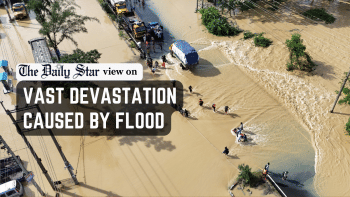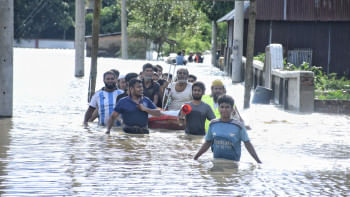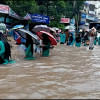Check spread of waterborne diseases in flood-hit areas

We are worried about the outbreak of waterborne diseases, particularly diarrhoea, in the flood-hit communities. The situation is said to be especially alarming in the worst-hit areas like Feni, Noakhali, and surrounding districts, where floodwaters are receding much slower than expected, thus increasing the risks of diseases. Although the authorities have correctly identified the crisis of safe drinking water as a key problem, measures taken so far are proving to be inadequate. This underscores the need for further expanding ongoing efforts to both address the crisis of safe water and treat diseases emanating from the lack thereof.
A major challenge at the moment is the struggle of hospitals and health complexes that remain ill-equipped to handle the influx of patients. For example, Feni's Sonagazi Upazila Health Complex has 50 beds but is having to treat nearly double its capacity, with patients reported to be lying on the floors, staircases, and balconies. The Chhagalnaiya Upazila Health Complex, which has the same number of beds, had 126 patients on Saturday. The Feni General Hospital's diarrhoea ward, which has 18 beds, was accommodating eight times its capacity. Similarly, at the Noakhali General Hospital, a diarrhoea ward meant for 16 patients was treating 280. The two districts together contributed at least 32 in the overall flood death toll of 59.
The overflowing of patients has been ascribed to the submersion of tubewells during the flood—which contaminated the water source and caused waterborne diseases to spread—but also to the flooding of many community clinics, upazila health complexes, and even district hospitals, which multiplied the pressure on the remaining facilities. The result is that thousands have been left without access to basic medical care at a time when it was most needed. The government has tried to respond to the crisis by deploying 619 medical teams across the 11 flood-hit districts. But considering the scale of the disaster, there is clearly a need to increase the number of such teams, and ensure that they reach remote and worst-hit areas, as patients cannot be expected to travel long distances because of the communication disruptions caused by the flood.
Going forward, the government also must restore and strengthen the health infrastructure in affected regions. Reopening all community clinics, which are often the only source of healthcare for rural populations, is particularly important, as is ensuring the availability of safe water. The current crisis has once again laid bare the pitfalls of our disaster management systems. Bangladesh is no stranger to such calamities, yet the recurring issues of overwhelmed health facilities and lack of clean water after any major flood suggest that much needs to be improved. It is crucial to invest in building a more resilient health system that can respond effectively to such emergencies.


 For all latest news, follow The Daily Star's Google News channel.
For all latest news, follow The Daily Star's Google News channel. 










Comments